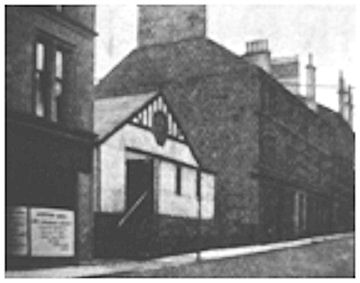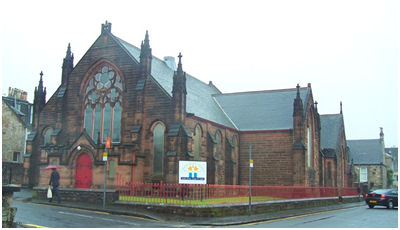Sites and Monuments Record
| Falkirk Baptist Church | SMR 1101 | NS 887 801; NS 890 799; NS 8871 7989; NS 8896 8013 |
TIMELINE
1808: An already existent congregation is recorded as having met in an upstairs room in Kirk Wynd.
1820: There were also two Scottish Baptist Churches in Falkirk.
1835: The old Congregational Church in Bank Street (NS 8884 8000) bought by Robert Walker, shipmaster, Grahamston, who fitted it up with a baptismal font and let it to the Baptist congregation for £6 annually.
1842: Bank Street Church closed.
A breakaway of twelve members met in a house in Callendar Riggs (sold in 1849).
Other brethren met in Wilson’s Hall.
The two Scottish Baptist Churches united and built a church in Callendar Riggs. They later moved to Swords Wynd, where through lack of funds, they were forced to dissolve.
1864: William Downs, shoemaker, built a two storey block in the Howgate adjoining Swords Wynd and gave the congregation the use of the upper floor in May (NS 8871 7989). This united the two factions but only for three weeks.
1866: Meetings collapsed after prolonged arguments. Downs left the town, as did the pastor, McDonald.
MacDonald returned and meetings resumed at Bainsford Bridge Hall; then at Falkirk Town Hall; then the Masonic Hall; the Town Hall again; and the Oddfellows’ Hall, Grahamston.
1870: Congregation dissolved.
1883: Some of the Baptist congregations united and with the support of James Wilson of Bantaskine appointed a minister.
1885: Building in Callendar Riggs for 150 people (NS 890 799).

1885, Jan: Iron church opened in Melville Street. It measured 60ft (72 with the function rooms) by 36ft, and sat 400 with a 4ft wide central aisle. Built by Messrs Crogan and Co, corrugated iron manufacturers, London, for £500. Half of the cost of the structure was paid for by James Wilson. Wood and felt were also used in the construction, but it became known locally as the “tin kirk”. (It was later used as a cinema and then an agricultural building near Edinburgh).

1897: New church erected in Orchard Street on the corner of Weir Street and opened in October. Built in the Gothic style in red stone from Locharbriggs Quarry, Dumfries, with English green slate on the roof. An open barrel roof of pitch pine. There was a choir platform, and above that a pulpit platform fitted with a baptismal font. South of the church were ladies and gents retiring rooms, so arranged that they could be amalgamated to form a schoolroom or church hall. Behind these was a vestry and kitchen, with lavatory accommodation. The main entrance to the church is on Orchard Street through a small porch in the gable, with a secondary entrance on Weir Street. The porch is of ashlar inside and outside, with an elegant tracery window above. It is contained in two of the buttresses, which are finished on top with pinnacles. The church is unusual in having a sloping floor. Total cost £2000, of which half was again contributed by the Wilson family. Designed by G Deas Page, and executed by John Gardner, mason.
The church is part of the English Baptist Union.
1904: Church of Christ building erected in Weir Street. This church is the natural successor to the Scottish Baptists.
1905: In September two new halls were opened along with a vestry, ladies and gents rooms and a deacons’ room (which had been the former vestry, but now forms part of the kitchen). George Deas Page was again the architect and again the Wilson family contributed £2,300, being half the cost. In March the following year the church sanctuary was re-opened with the addition of two transepts. The extended platform now contained a new pulpit and an open baptistery made of Sicilian marble. The south transept replaced the original hall.
MANSE
1923: Up until this year the church had rented a house in Cochrane Street. In April “Ingleside” in Woodlands Crescent was bought for £750. Part of the money for this came from the rental of the church halls to the Employment Exchange.
FITTINGS
1897: Silver communion plates “Presented to Falkirk Baptist Church by Mrs A McIllwraith in memory of her father James Towers. November 7th 1897.” Communion cups “Presented to the Falkirk Baptist Church by Mr & Mrs AA Skeene, Larbert. 10th Oct 1897.”
1957: Communion table “In loving memory of Mr and Mrs Andrew Balfour Gray, for many years worshippers at Falkirk Baptist Church. Gifted by their daughter Mrs Gladys M B Hardie. 25th June 1957.”
WINDOWS
See separate entry for stained glass.
SEATING
Callendar Riggs 150
1885: Melville Street 400
1897: Orchard Street 320 including the choir.
MINISTERS OF FALKIRK BAPTIST CHURCH
| 1809 | Dunbar, Daniel | 1835 |
| 1837 | Smith, Alexander | |
| 1865 | Gibb, Peter | |
| Downs (stood in) | ||
| McDonald, John | ||
| 1868 | Spence, John Lang | Jan 1870 |
| Fisher, George | ||
| Wilson, George | ||
| MacPherson, Duncan | ||
| Oct 1883 | Mathams, Walter J. | Oct 1888 |
| Sep 1889 | Paterson, Alexander | May 1922 |
| Oct 1923 | Lyle, Graham | Nov 1926 |
| Dec 1926 | Crawley, Frederick | Jul 1935 |
| Dec 1935 | Paterson, William | Oct 1940 |
| Apr 1941 | Cook, Mathew | Oct 1954 |
| May 1955 | Lyons, John | Oct 1980 |
| Mar 1982 | Reed, Ian | May 1987 |
| Jan 1988 | White, David | May 1991 |
| Aug 1992 | Cameron, Colin |
G.B. Bailey (2019)
***********************************************************************
CHURCH OF CHRIST
| NS 8922 8013 | NS 8867 7923 |
Arose out of the ashes of the Scottish Baptists. Worship in Lorne Hall, Burns Court, then in Rankine’s Hall.
1870-74: Occupied the Howgate Chapel and sold it to the E.U. Church.
1904: Church built in Pleasance Gardens for £420. Demolished 2017.
G.B. Bailey (2019)
***********************************************************************

